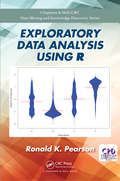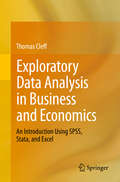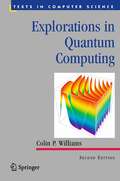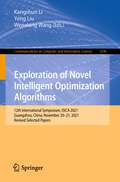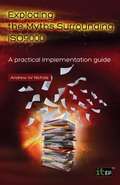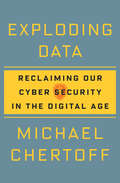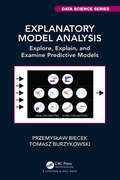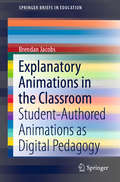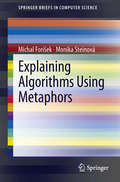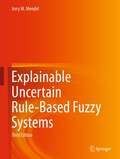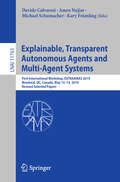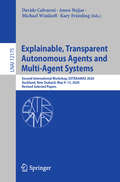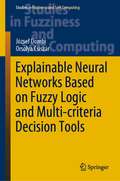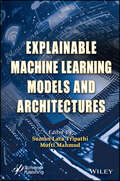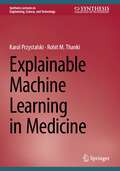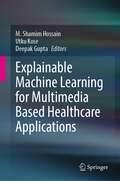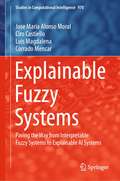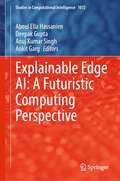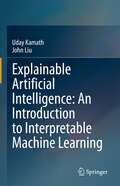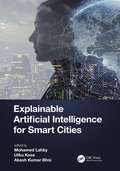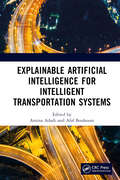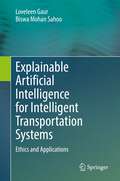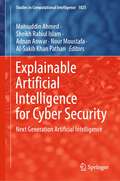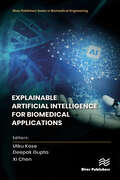- Table View
- List View
Exploratory Data Analysis Using R (Chapman and Hall/CRC Data Mining and Knowledge Discovery Series)
by Ronald K. PearsonExploratory Data Analysis Using R provides a classroom-tested introduction to exploratory data analysis (EDA) and introduces the range of "interesting" – good, bad, and ugly – features that can be found in data, and why it is important to find them. It also introduces the mechanics of using R to explore and explain data. The book begins with a detailed overview of data, exploratory analysis, and R, as well as graphics in R. It then explores working with external data, linear regression models, and crafting data stories. The second part of the book focuses on developing R programs, including good programming practices and examples, working with text data, and general predictive models. The book ends with a chapter on "keeping it all together" that includes managing the R installation, managing files, documenting, and an introduction to reproducible computing. The book is designed for both advanced undergraduate, entry-level graduate students, and working professionals with little to no prior exposure to data analysis, modeling, statistics, or programming. it keeps the treatment relatively non-mathematical, even though data analysis is an inherently mathematical subject. Exercises are included at the end of most chapters, and an instructor's solution manual is available.
Exploratory Data Analysis in Business and Economics
by Thomas CleffIn a world in which we are constantly surrounded by data, figures, and statistics, it is imperative to understand and to be able to use quantitative methods. Statistical models and methods are among the most important tools in economic analysis, decision-making and business planning. This textbook, "Exploratory Data Analysis in Business and Economics", aims to familiarise students of economics and business as well as practitioners in firms with the basic principles, techniques, and applications of descriptive statistics and data analysis. Drawing on practical examples from business settings, it demonstrates the basic descriptive methods of univariate and bivariate analysis. The textbook covers a range of subject matter, from data collection and scaling to the presentation and univariate analysis of quantitative data, and also includes analytic procedures for assessing bivariate relationships. It does not confine itself to presenting descriptive statistics, but also addresses the use of computer programmes such as Excel, SPSS, and STATA, thus treating all of the topics typically covered in a university course on descriptive statistics. The German edition of this textbook is one of the "bestsellers" on the German market for literature in statistics.
Explorations in Quantum Computing
by Colin P. WilliamsBy the year 2020, the basic memory components of a computer will be the size of individual atoms. At such scales, the current theory of computation will become invalid. "Quantum computing" is reinventing the foundations of computer science and information theory in a way that is consistent with quantum physics - the most accurate model of reality currently known. Remarkably, this theory predicts that quantum computers can perform certain tasks breathtakingly faster than classical computers - and, better yet, can accomplish mind-boggling feats such as teleporting information, breaking supposedly "unbreakable" codes, generating true random numbers, and communicating with messages that betray the presence of eavesdropping. This widely anticipated second edition of Explorations in Quantum Computing explains these burgeoning developments in simple terms, and describes the key technological hurdles that must be overcome to make quantum computers a reality. This easy-to-read, time-tested, and comprehensive textbook provides a fresh perspective on the capabilities of quantum computers, and supplies readers with the tools necessary to make their own foray into this exciting field. Topics and features: concludes each chapter with exercises and a summary of the material covered; provides an introduction to the basic mathematical formalism of quantum computing, and the quantum effects that can be harnessed for non-classical computation; discusses the concepts of quantum gates, entangling power, quantum circuits, quantum Fourier, wavelet, and cosine transforms, and quantum universality, computability, and complexity; examines the potential applications of quantum computers in areas such as search, code-breaking, solving NP-Complete problems, quantum simulation, quantum chemistry, and mathematics; investigates the uses of quantum information, including quantum teleportation, superdense coding, quantum data compression, quantum cloning, quantum negation, and quantum cryptography; reviews the advancements made towards practical quantum computers, covering developments in quantum error correction and avoidance, and alternative models of quantum computation. This text/reference is ideal for anyone wishing to learn more about this incredible, perhaps "ultimate," computer revolution. Dr. Colin P. Williams is Program Manager for Advanced Computing Paradigms at the NASA Jet Propulsion Laboratory, California Institute of Technology, and CEO of Xtreme Energetics, Inc. an advanced solar energy company. Dr. Williams has taught quantum computing and quantum information theory as an acting Associate Professor of Computer Science at Stanford University. He has spent over a decade inspiring and leading high technology teams and building business relationships with and Silicon Valley companies. Today his interests include terrestrial and Space-based power generation, quantum computing, cognitive computing, computational material design, visualization, artificial intelligence, evolutionary computing, and remote olfaction. He was formerly a Research Scientist at Xerox PARC and a Research Assistant to Prof. Stephen W. Hawking, Cambridge University.
Exploration of Quantum Transport Phenomena via Engineering Emergent Magnetic Fields in Topological Magnets (Springer Theses)
by Yukako FujishiroThis book addresses novel electronic and thermoelectronic properties arising from topological spin textures as well as topologically non-trivial electronic structures. In particular, it focuses on a unique topological spin texture, i.e., spin hedgehog lattice, emerging in a chiral magnet and explore its novel properties which are distinct from the conventional skyrmion lattice, and discusses the possibility of realizing high-temperature quantum anomalous Hall effect through quantum confinement effect in topological semimetal. This book benefits students and researchers working in the field of condensed matter physics, through providing comprehensive understanding of the current status and the outlook in the field of topological magnets.
Exploration of Novel Intelligent Optimization Algorithms: 12th International Symposium, ISICA 2021, Guangzhou, China, November 20–21, 2021, Revised Selected Papers (Communications in Computer and Information Science #1590)
by Kangshun Li Yong Liu Wenxiang WangThis book constitutes the refereed proceedings of the 12th International Symposium, ISICA 2021, held in Guangzhou, China, during November 19–21, 2021. The 48 full papers included in this book were carefully reviewed and selected from 99 submissions. They were organized in topical sections as follows: new frontier of multi-objective evolutionary algorithms; intelligent multi-media; data modeling and application of artificial intelligence; exploration of novel intelligent optimization algorithm; and intelligent application of industrial production.
Exploding the Myths Surrounding ISO9000
by Andrew W. NicholsThe secrets of successful ISO9000 implementation Thousands of companies worldwide are reaping the benefits from adopting the ISO9000 family of quality management standards. However, there are many conflicting opinions about ISO9000s best practice approach. Some companies have delayed adopting ISO9000, or have chosen not to undertake implementation at all. This might be because of a lack of time and resources to investigate it properly, or because of misunderstandings about the way it works. So, how do we know who and what to believe? In Exploding the Myths Surrounding ISO9000, Andrew W Nichols debunks many of the common misconceptions about ISO9001 and describes the many advantages it brings. Drawing on more than 25 years of hands-on experience, Andy gives clear, practical and up-to-date advice on how to implement a Quality Management System to maximum effect. Full of real-life examples, this book enables you to read and interpret the ISO9000 documentation. With the advice in this book, you can foster an effective ISO9000 system that brings increased efficiencies, reduces waste and fuels growth in sales as you better understand and meet the needs of your customers. About the author Andrew W Nichols has more than 25 years of experience of management systems, in both the UK and the USA. As a trainer, he has delivered hundreds of ISO9000 related courses to audiences ranging from shop-floor personnel to CEOs of Fortune 500 companies. He has also led and contributed to the development of best in class training courses for a number of international standards. Andy is a regular contributor to the well-known Elsmar Cove internet forum for management systems. Read this unique book and make ISO9000 work for you.
Exploding Data: Reclaiming Our Cyber Security in the Digital Age
by Michael ChertoffA former Secretary of Homeland Security examines our outdated laws regarding the protection of personal information, and the pressing need for change. Nothing undermines our freedom more than losing control of information about ourselves. And yet, as daily events underscore, we are ever more vulnerable to cyber-attack. In this bracing book, Michael Chertoff makes clear that our laws and policies surrounding the protection of personal information, written for an earlier time, are long overdue for a complete overhaul. On the one hand, the collection of data—more widespread by business than by government, and impossible to stop—should be facilitated as an ultimate protection for society. On the other, standards under which information can be inspected, analyzed, or used must be significantly tightened. In offering his compelling call for action, Chertoff argues that what is at stake is not so much the simple loss of privacy, which is almost impossible to protect, but of individual autonomy—the ability to make personal choices free of manipulation or coercion. Offering vivid stories over many decades that illuminate the three periods of data gathering we have experienced, Chertoff explains the complex legalities surrounding issues of data collection and dissemination today, and charts a path that balances the needs of government, business, and individuals alike. &“Surveys the brave new world of data collection and analysis…The world of data as illuminated here would have scared George Orwell.&”―Kirkus Reviews &“Chertoff has a unique perspective on data security and its implications for citizen rights as he looks at the history of and changes in privacy laws since the founding of the U.S.&”—Booklist
Explanatory Model Analysis: Explore, Explain, and Examine Predictive Models (Chapman & Hall/CRC Data Science Series)
by Tomasz Burzykowski Przemyslaw BiecekExplanatory Model Analysis Explore, Explain and Examine Predictive Models is a set of methods and tools designed to build better predictive models and to monitor their behaviour in a changing environment. Today, the true bottleneck in predictive modelling is neither the lack of data, nor the lack of computational power, nor inadequate algorithms, nor the lack of flexible models. It is the lack of tools for model exploration (extraction of relationships learned by the model), model explanation (understanding the key factors influencing model decisions) and model examination (identification of model weaknesses and evaluation of model's performance). This book presents a collection of model agnostic methods that may be used for any black-box model together with real-world applications to classification and regression problems.
Explanatory Animations in the Classroom: Student-Authored Animations as Digital Pedagogy (SpringerBriefs in Education)
by Brendan JacobsThis book provides groundbreaking evidence demonstrating how student-authored explanatory animations can embody and document learning as an exciting new development within digital pedagogy. Explanatory animations can be an excellent resource for teaching and learning but there has been an underlying assumption that students are predominately viewers rather than animation authors. The methodology detailed in this book reverses this scenario by putting students in the driver’s seat of their own learning. This signals not just a change in perspective, but a complete change in activity that, to continue the analogy, will forever change the conversation and make redundant phrases like “Are we there yet?” and “How much longer?” The digital nature of such practices provides compelling evidence for reconceptualising explanatory animation creation as a pedagogical activity that generates multimodal assessment data. Tying together related themes to advance approaches to evidence-based assessment using digital technologies, this book is intended for educators at any stage of their journey, including pre-service teachers.
Explaining Algorithms Using Metaphors
by Michal Forišek Monika SteinováThere is a significant difference between designing a new algorithm, proving its correctness, and teaching it to an audience. When teaching algorithms, the teacher's main goal should be to convey the underlying ideas and to help the students form correct mental models related to the algorithm. This process can often be facilitated by using suitable metaphors. This work provides a set of novel metaphors identified and developed as suitable tools for teaching many of the "classic textbook" algorithms taught in undergraduate courses worldwide. Each chapter provides exercises and didactic notes for teachers based on the authors' experiences when using the metaphor in a classroom setting.
Explainable Uncertain Rule-Based Fuzzy Systems
by Jerry M. MendelThe third edition of this textbook presents a further updated approach to fuzzy sets and systems that can model uncertainty — i.e., “type-2” fuzzy sets and systems. The author demonstrates how to overcome the limitations of classical fuzzy sets and systems, enabling a wide range of applications, from time-series forecasting to knowledge mining to classification to control and to explainable AI (XAI). This latest edition again begins by introducing classical (type-1) fuzzy sets and systems, and then explains how they can be modified to handle uncertainty, leading to type-2 fuzzy sets and systems. New material is included about how to obtain fuzzy set word models that are needed for XAI, similarity of fuzzy sets, a quantitative methodology that lets one explain in a simple way why the different kinds of fuzzy systems have the potential for performance improvements over each other, and new parameterizations of membership functions that have the potential for achieving even greater performance for all kinds of fuzzy systems. For hands-on experience, the book provides information on accessing MATLAB, Java, and Python software to complement the content. The book features a full suite of classroom material.
Explainable, Transparent Autonomous Agents and Multi-Agent Systems: First International Workshop, EXTRAAMAS 2019, Montreal, QC, Canada, May 13–14, 2019, Revised Selected Papers (Lecture Notes in Computer Science #11763)
by Davide Calvaresi Amro Najjar Michael Schumacher Kary FrämlingThis book constitutes the proceedings of the First International Workshop on Explainable, Transparent Autonomous Agents and Multi-Agent Systems, EXTRAAMAS 2019, held in Montreal, Canada, in May 2019. The 12 revised and extended papers presented were carefully selected from 23 submissions. They are organized in topical sections on explanation and transparency; explainable robots; opening the black box; explainable agent simulations; planning and argumentation; explainable AI and cognitive science.
Explainable, Transparent Autonomous Agents and Multi-Agent Systems: Second International Workshop, EXTRAAMAS 2020, Auckland, New Zealand, May 9–13, 2020, Revised Selected Papers (Lecture Notes in Computer Science #12175)
by Davide Calvaresi Amro Najjar Michael Winikoff Kary FrämlingThis book constitutes the proceedings of the Second International Workshop on Explainable, Transparent Autonomous Agents and Multi-Agent Systems, EXTRAAMAS 2020, which was due to be held in Auckland, New Zealand, in May 2020. The conference was held virtually due to the COVID-19 pandemic.The 8 revised and extended papers were carefully selected from 20 submissions and are presented here with one demo paper. The papers are organized in the following topical sections: explainable agents; cross disciplinary XAI; explainable machine learning; demos.
Explainable Neural Networks Based on Fuzzy Logic and Multi-criteria Decision Tools (Studies in Fuzziness and Soft Computing #408)
by József Dombi Orsolya CsiszárThe research presented in this book shows how combining deep neural networks with a special class of fuzzy logical rules and multi-criteria decision tools can make deep neural networks more interpretable – and even, in many cases, more efficient. Fuzzy logic together with multi-criteria decision-making tools provides very powerful tools for modeling human thinking. Based on their common theoretical basis, we propose a consistent framework for modeling human thinking by using the tools of all three fields: fuzzy logic, multi-criteria decision-making, and deep learning to help reduce the black-box nature of neural models; a challenge that is of vital importance to the whole research community.
Explainable Machine Learning Models and Architectures
by Suman Lata Tripathi Mufti MahmudEXPLAINABLE MACHINE LEARNING MODELS AND ARCHITECTURES This cutting-edge new volume covers the hardware architecture implementation, the software implementation approach, and the efficient hardware of machine learning applications. Machine learning and deep learning modules are now an integral part of many smart and automated systems where signal processing is performed at different levels. Signal processing in the form of text, images, or video needs large data computational operations at the desired data rate and accuracy. Large data requires more use of integrated circuit (IC) area with embedded bulk memories that further lead to more IC area. Trade-offs between power consumption, delay and IC area are always a concern of designers and researchers. New hardware architectures and accelerators are needed to explore and experiment with efficient machine-learning models. Many real-time applications like the processing of biomedical data in healthcare, smart transportation, satellite image analysis, and IoT-enabled systems have a lot of scope for improvements in terms of accuracy, speed, computational powers, and overall power consumption. This book deals with the efficient machine and deep learning models that support high-speed processors with reconfigurable architectures like graphic processing units (GPUs) and field programmable gate arrays (FPGAs), or any hybrid system. Whether for the veteran engineer or scientist working in the field or laboratory, or the student or academic, this is a must-have for any library.
Explainable Machine Learning in Medicine (Synthesis Lectures on Engineering, Science, and Technology)
by Karol Przystalski Rohit M. ThankiThis book covers a variety of advanced communications technologies that can be used to analyze medical data and can be used to diagnose diseases in clinic centers. The book is a primer of methods for medicine, providing an overview of explainable artificial intelligence (AI) techniques that can be applied in different medical challenges. The authors discuss how to select and apply the proper technology depending on the provided data and the analysis desired. Because a variety of data can be used in the medical field, the book explains how to deal with challenges connected with each type. A number of scenarios are introduced that can happen in real-time environments, with each pared with a type of machine learning that can be used to solve it.
Explainable Machine Learning for Multimedia Based Healthcare Applications
by M. Shamim Hossain Utku Kose Deepak GuptaThis book covers the latest research studies regarding Explainable Machine Learning used in multimedia-based healthcare applications. In this context, the content includes not only introductions for applied research efforts but also theoretical touches and discussions targeting open problems as well as future insights. In detail, a comprehensive topic coverage is ensured by focusing on remarkable healthcare problems solved with Artificial Intelligence. Because today’s conditions in medical data processing are often associated with multimedia, the book considers research studies with especially multimedia data processing.
Explainable Fuzzy Systems: Paving the Way from Interpretable Fuzzy Systems to Explainable AI Systems (Studies in Computational Intelligence #970)
by Jose Maria Alonso Moral Ciro Castiello Luis Magdalena Corrado MencarThe importance of Trustworthy and Explainable Artificial Intelligence (XAI) is recognized in academia, industry and society. This book introduces tools for dealing with imprecision and uncertainty in XAI applications where explanations are demanded, mainly in natural language. Design of Explainable Fuzzy Systems (EXFS) is rooted in Interpretable Fuzzy Systems, which are thoroughly covered in the book. The idea of interpretability in fuzzy systems, which is grounded on mathematical constraints and assessment functions, is firstly introduced. Then, design methodologies are described. Finally, the book shows with practical examples how to design EXFS from interpretable fuzzy systems and natural language generation. This approach is supported by open source software. The book is intended for researchers, students and practitioners who wish to explore EXFS from theoretical and practical viewpoints. The breadth of coverage will inspire novel applications and scientific advancements.
Explainable Edge AI: A Futuristic Computing Perspective (Studies in Computational Intelligence #1072)
by Aboul Ella Hassanien Deepak Gupta Anuj Kumar Singh Ankit GargThis book presents explainability in edge AI, an amalgamation of edge computing and AI. The issues of transparency, fairness, accountability, explainability, interpretability, data-fusion, and comprehensibility that are significant for edge AI are being addressed in this book through explainable models and techniques. The concept of explainable edge AI is new in front of the academic and research community, and consequently, it will undoubtedly explore multiple research dimensions. The book presents the concept of explainability in edge AI which is the amalgamation of edge computing and AI. In the futuristic computing scenario, the goal of explainable edge AI will be to execute the AI tasks and produce explainable results at the edge. First, this book explains the fundamental concepts of explainable artificial intelligence (XAI), then it describes the concept of explainable edge AI, and finally, it elaborates on the technicalities of explainability in edge AI. Owing to the quick transition in the current computing scenario and integration with the latest AI-based technologies, it is significant to facilitate people-centric computing through explainable edge AI. Explainable edge AI will facilitate enhanced prediction accuracy with the comprehensible decision and traceability of actions performed at the edge and have a significant impact on futuristic computing scenarios. This book is highly relevant to graduate/postgraduate students, academicians, researchers, engineers, professionals, and other personnel working in artificial intelligence, machine learning, and intelligent systems.
Explainable Artificial Intelligence: An Introduction to Interpretable Machine Learning
by Uday Kamath John LiuThis book is written both for readers entering the field, and for practitioners with a background in AI and an interest in developing real-world applications. The book is a great resource for practitioners and researchers in both industry and academia, and the discussed case studies and associated material can serve as inspiration for a variety of projects and hands-on assignments in a classroom setting. I will certainly keep this book as a personal resource for the courses I teach, and strongly recommend it to my students. --Dr. Carlotta Domeniconi, Associate Professor, Computer Science Department, GMUThis book offers a curriculum for introducing interpretability to machine learning at every stage. The authors provide compelling examples that a core teaching practice like leading interpretive discussions can be taught and learned by teachers and sustained effort. And what better way to strengthen the quality of AI and Machine learning outcomes. I hope that this book will become a primer for teachers, data Science educators, and ML developers, and together we practice the art of interpretive machine learning.--Anusha Dandapani, Chief Data and Analytics Officer, UNICC and Adjunct Faculty, NYUThis is a wonderful book! I’m pleased that the next generation of scientists will finally be able to learn this important topic. This is the first book I’ve seen that has up-to-date and well-rounded coverage. Thank you to the authors!--Dr. Cynthia Rudin, Professor of Computer Science, Electrical and Computer Engineering, Statistical Science, and Biostatistics & Bioinformatics Literature on Explainable AI has up until now been relatively scarce and featured mainly mainstream algorithms like SHAP and LIME. This book has closed this gap by providing an extremely broad review of various algorithms proposed in the scientific circles over the previous 5-10 years. This book is a great guide to anyone who is new to the field of XAI or is already familiar with the field and is willing to expand their knowledge. A comprehensive review of the state-of-the-art Explainable AI methods starting from visualization, interpretable methods, local and global explanations, time series methods, and finishing with deep learning provides an unparalleled source of information currently unavailable anywhere else. Additionally, notebooks with vivid examples are a great supplement that makes the book even more attractive for practitioners of any level.Overall, the authors provide readers with an enormous breadth of coverage without losing sight of practical aspects, which makes this book truly unique and a great addition to the library of any data scientist.Dr. Andrey Sharapov, Product Data Scientist, Explainable AI Expert and Speaker, Founder of Explainable AI-XAI Group
Explainable Artificial Intelligence for Smart Cities
by Mohamed LahbyThanks to rapid technological developments in terms of Computational Intelligence, smart tools have been playing active roles in daily life. It is clear that the 21st century has brought about many advantages in using high-level computation and communication solutions to deal with real-world problems; however, more technologies bring more changes to society. In this sense, the concept of smart cities has been a widely discussed topic in terms of society and Artificial Intelligence-oriented research efforts. The rise of smart cities is a transformation of both community and technology use habits, and there are many different research orientations to shape a better future. The objective of this book is to focus on Explainable Artificial Intelligence (XAI) in smart city development. As recently designed, advanced smart systems require intense use of complex computational solutions (i.e., Deep Learning, Big Data, IoT architectures), the mechanisms of these systems become ‘black-box’ to users. As this means that there is no clear clue about what is going on within these systems, anxieties regarding ensuring trustworthy tools also rise. In recent years, attempts have been made to solve this issue with the additional use of XAI methods to improve transparency levels. This book provides a timely, global reference source about cutting-edge research efforts to ensure the XAI factor in smart city-oriented developments. The book includes both positive and negative outcomes, as well as future insights and the societal and technical aspects of XAI-based smart city research efforts. This book contains nineteen contributions beginning with a presentation of the background of XAI techniques and sustainable smart-city applications. It then continues with chapters discussing XAI for Smart Healthcare, Smart Education, Smart Transportation, Smart Environment, Smart Urbanization and Governance, and Cyber Security for Smart Cities.
Explainable Artificial Intelligence for Intelligent Transportation Systems
by Amina Adadi Afaf BouhouteArtificial Intelligence (AI) and Machine Learning (ML) are set to revolutionize all industries, and the Intelligent Transportation Systems (ITS) field is no exception. While ML, especially deep learning models, achieve great performance in terms of accuracy, the outcomes provided are not amenable to human scrutiny and can hardly be explained. This can be very problematic, especially for systems of a safety-critical nature such as transportation systems. Explainable AI (XAI) methods have been proposed to tackle this issue by producing human interpretable representations of machine learning models while maintaining performance. These methods hold the potential to increase public acceptance and trust in AI-based ITS. FEATURES: Provides the necessary background for newcomers to the field (both academics and interested practitioners) Presents a timely snapshot of explainable and interpretable models in ITS applications Discusses ethical, societal, and legal implications of adopting XAI in the context of ITS Identifies future research directions and open problems
Explainable Artificial Intelligence for Intelligent Transportation Systems: Ethics and Applications
by Loveleen Gaur Biswa Mohan SahooTransportation typically entails crucial “life-death” choices, delegating crucial decisions to an AI algorithm without any explanation poses a serious threat. Hence, explainability and responsible AI is crucial in the context of intelligent transportation. In Intelligence Transportation System (ITS) implementations such as traffic management systems and autonomous driving applications, AI-based control mechanisms are gaining prominence.Explainable artificial intelligence for intelligent transportation system tackling certain challenges in the field of autonomous vehicle, traffic management system, data integration and analytics and monitor the surrounding environment.The book discusses and inform researchers on explainable Intelligent Transportation system. It also discusses prospective methods and techniques for enabling the interpretability of transportation systems. The book further focuses on ethical considerations apart from technical considerations.
Explainable Artificial Intelligence for Cyber Security: Next Generation Artificial Intelligence (Studies in Computational Intelligence #1025)
by Mohiuddin Ahmed Sheikh Rabiul Islam Adnan Anwar Nour Moustafa Al-Sakib Khan PathanThis book presents that explainable artificial intelligence (XAI) is going to replace the traditional artificial, machine learning, deep learning algorithms which work as a black box as of today. To understand the algorithms better and interpret the complex networks of these algorithms, XAI plays a vital role. In last few decades, we have embraced AI in our daily life to solve a plethora of problems, one of the notable problems is cyber security. In coming years, the traditional AI algorithms are not able to address the zero-day cyber attacks, and hence, to capitalize on the AI algorithms, it is absolutely important to focus more on XAI. Hence, this book serves as an excellent reference for those who are working in cyber security and artificial intelligence.
Explainable Artificial Intelligence for Biomedical Applications (River Publishers Series in Biomedical Engineering)
by Utku Kose Deepak Gupta Xi ChenSince its first appearance, artificial intelligence has been ensuring revolutionary outcomes in the context of real-world problems. At this point, it has strong relations with biomedical and today’s intelligent systems compete with human capabilities in medical tasks. However, advanced use of artificial intelligence causes intelligent systems to be black-box. That situation is not good for building trustworthy intelligent systems in medical applications. For a remarkable amount of time, researchers have tried to solve the black-box issue by using modular additions, which have led to the rise of the term: interpretable artificial intelligence. As the literature matured (as a result of, in particular, deep learning), that term transformed into explainable artificial intelligence (XAI). This book provides an essential edited work regarding the latest advancements in explainable artificial intelligence (XAI) for biomedical applications. It includes not only introductive perspectives but also applied touches and discussions regarding critical problems as well as future insights. Topics discussed in the book include: XAI for the applications with medical images XAI use cases for alternative medical data/task Different XAI methods for biomedical applications Reviews for the XAI research for critical biomedical problems. Explainable Artificial Intelligence for Biomedical Applications is ideal for academicians, researchers, students, engineers, and experts from the fields of computer science, biomedical, medical, and health sciences. It also welcomes all readers of different fields to be informed about use cases of XAI in black-box artificial intelligence. In this sense, the book can be used for both teaching and reference source purposes.
